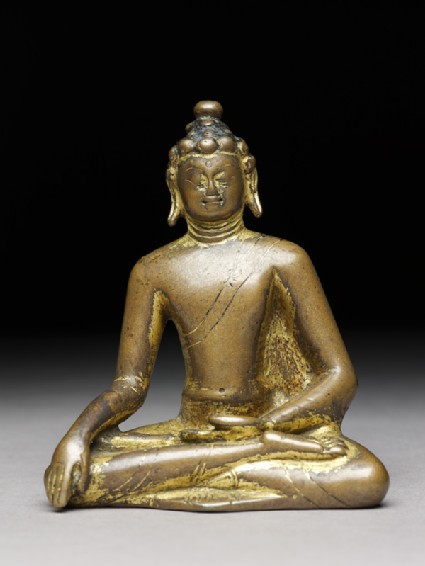Browse: 107 objects
- Reference URL
Actions
Seated figure of the Buddha
-
Details
- Associated place
- Date
- 8th - 9th century AD (AD 701 - 900)
- Associated people
-
the Buddha (active c. 560 BC - c. 486 BC) (subject)
- Material and technique
- gilt bronze
- Dimensions
- 9.5 x 8.1 x 5 cm max. (height x width x depth)
- Material index
-
processed material › metal › alloy › copper alloy › bronze,
- Technique index
-
covered › metallized › gilded
- Object type index
- No. of items
- 1
- Credit line
- Purchased with the assistance of the Art Fund and the Friends of the Ashmolean Museum, 1997.
- Accession no.
- EA1997.187
-
Further reading
Heller, Amy, Early Himalayan Art (Oxford: Ashmolean Museum, 2008), no. 24 on pp. 90-91, pp. 15, 26 & 115, illus. p. 91
Location
Objects are sometimes moved to a different location. Our object location data is usually updated on a monthly basis. Contact the Jameel Study Centre if you are planning to visit the museum to see a particular object on display, or would like to arrange an appointment to see an object in our reserve collections.
Galleries
Publications online
-

Early Himalayan Art
This Buddha was formerly completely gilt, with blue pigment applied over the hair. Its metal is now somewhat reddish in colour, indicating a very high copper content in the alloy. This high copper level has made the surface of the sculpture soft, resulting in much surface wear to the facial features. The statue is heavy and appears to be solid cast, as there is a cavity under the Buddha's legs. On the back above the shoulder- blades there is a tang for attachment to a prabha, and again beneath the buttocks. This would have connected the Buddha to his lotus pedestal, separately cast and now missing. Examination of the underside reveals that the shell of the statue is quite thick: there is a rim which is 1 cm wide, upon which the square tang is positioned.
The Buddha has a spherical jewel finial above the dome of his ushnisha, formed by four copper beads. The hair curls also are formed by spherical copper beads of irregular size. The ears are quite stylized, for instead of the long lobes hanging naturalistically, the lower lobes protrude laterally at a pronounced angle. This curious treatment of the lobe is found on many Buddha images now found in Tibet which are dated to around the ninth century [1]. It also recalls the Buddha figures in the carved lintels of the Lhasa Jokhang, of the eighth to ninth century. The square hairline, full cheeks, and rounded face with a slightly square jaw are characteristic of sculpture of the Licchavi period, as are the fine facial features, with small almond eyes and small mouth with full lips. The nose now appears flat and wide at the nostrils but this is due to wear, while the bridge of the nose is narrow. The face looks straight ahead.
The body proportions are strong yet slender. The abdomen is just rounded at the waist, and the navel is punched in recess. These elegant proportions are characteristic of the Licchavi aesthetic [2]. The samghati clings so closely to the body that its edge is merely indicated by incised lines marking the edge of the hem as a diagonal line at the level of the chest and shoulder. Two hems are visible on the legs: one robe-edge at mid-calf and another near the ankles. This unusual treatment of the robe may also be observed on the seated Buddha from Nepal (cat. 5), and another seated Buddha from Nepal, attributed to the tenth to eleventh century, in the Ford Collection [3]. The facial f e a t u res of the Ashmolean Buddha are closer to c i rc a ninth-century Buddha images now in Tibet. The strong right hand forms the bhumisparsha (earth-touching) mudra; the fingers are elongated. The palm of the left hand, resting in the lap, and the soles of the feet have the sacred circular markings. The mood of this Buddha is gentle and alert.
In many respects this Buddha corresponds perfectly to the taste of the Licchavi period in Nepal, due to the casting in copper alloy, the proportions, and the facial features. A provenance from Nepal or Tibet in the eighth to ninth century may be suggested, as this sculpture also has similar proportions and hair to the Buddha figures carved in the wooden lintels of the earliest Buddhist sanctuary in Tibet, the Lhasa Jokhang. In view of the presence of Newar artists and artisans working in Tibet at this time, it was possibly made in Tibet; otherwise it could have been cast in Nepal and then brought to Tibet, where the blue pigment was applied to the hair in accordance with Tibetan consecration practices.
[Footnotes:]
1 von Schroeder, Buddhist Bronzes in Tibet, vol. 1, pls. 137-9.
2 Compare the 8th-9th-century Amoghapasa in the Nyingjei Lam collection: Weldon and Singer, The Sculptural Heritage of Tibet, pl. 9, and another Licchavi Amoghapasa from a private collection: Heller, 'Eighth- and Ninth-century Temples and Rock Carvings of Eastern Tibet', pl. 82.
3 Pal, Desire and Devotion, pl. 105.
© 2013 University of Oxford - Ashmolean Museum




